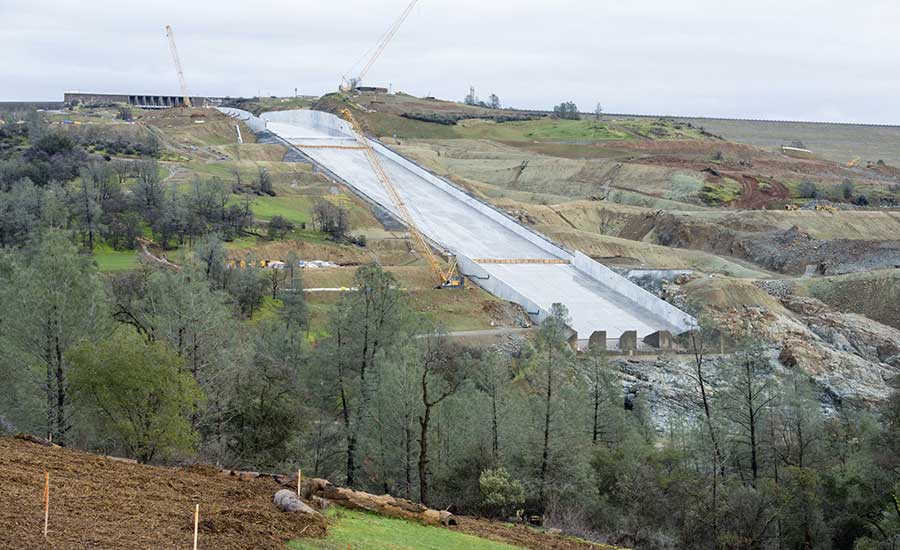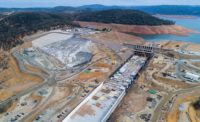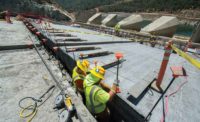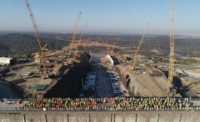Designing and building California’s $500-million Lake Oroville Spillways Emergency Recovery Project in just nine months—a job that typically would take 10 years—required an army of engineers and workers. Leading the charge in the construction effort, project director Jeff Petersen put his life on hold to guide the challenging first phase to an on-time completion without any lost-time injuries.
While Petersen serves as a senior vice president for general contractor Kiewit Infrastructure West Co. and chief of the firm’s northern California district, “Jeff stepped away from his executive responsibilities to go out and lead this project,” says Dave Miles, Kiewit executive vice president.
Just a few days after winning the extremely accelerated bid in April, Petersen and his team “were in our offices with lessons learned on the Folsom Dam spillway in terms of constructibility,” says Ted Craddock, project manager with the California Dept. of Water Resources. “It’s pretty clear when you’re around Jeff that he’s the leader in the room.”
 Jeff Petersen
Jeff Petersen
Fairfield, Calif.
ENR 12/11/17 p. 12
With drive and leadership skills partly learned from his Olympics-level rowing experience, Petersen guided his team to fix a damaged spillway and keep craft workers—and the community—safe.
Beginning work in May with less than a third of the design completed, Kiewit crews raced to rebuild and strengthen the dam’s 3,055-ft-long main spillway and adjacent emergency spillway, both damaged during record rainfall in February, when releases gouged an 1,100-ft-long, 200-ft-deep trench in the main spillway and undercut the emergency spillway. The damage caused officials to evacuate nearly 200,000 people living downstream for fear of catastrophic flooding.
The repair job was divided into two phases because work on the main spillway is off-limits during the winter rainy season, from December until May. Phase one, completed in November, rebuilt two sections of reinforced, structural erosion-control concrete in an 870-ft-long upper chute section and a 350-ft-long lower chute section. Crews also placed some 350,000 cu yd of roller-compacted concrete (RCC) in the middle section where the washout had occurred.
Tracking the “numerous changes that were occurring as the project was being developed, Petersen knew how to reach out to other resources, putting his ego aside, reaching out across the company and bringing in the strengths of the organization, to make sure that the job got done on time for the client,” Miles says.
Craddock says he was “impressed with [Petersen’s] professionalism, innovative thinking, commitment to accomplish what we set out to accomplish, and his drive and willingness to work cooperatively.”
A graduate of Oregon State University, Petersen credits his leadership skills to his post-college experience trying out for the 1988 U.S. Olympics rowing team. “I often connect the teamwork element and the drive and passion it takes to be successful at rowing and what it takes to be successful in construction, where the team has to be working together or it’s just inefficient and you don’t go anywhere,” Petersen says. “Oroville was all about teamwork and drive. Everybody had to be hitting on all cylinders and staying focused, regrouping when something went wrong and adjusting the course to keep going, because failure was not an option.”
Emergency-spillway improvements continue over the winter, with an on-site crew of about 190 to install a 1,450-ft-long secant-pile wall to prevent head-cutting erosion. In addition, a 730-ft-wide splash pad will be installed, requiring more than 500,000 cu yd of RCC. When work on the main spillway resumes in May, structural concrete will be placed on top of the RCC and temporary RCC buttress walls will be replaced.
To date, more than 600 Kiewit workers have performed 770,000 work-hours without a recordable incident. Because of the urgent nature of the repair, “it would have been really easy to say, ‘Safety has to go to the side because it’s all about cost and schedule and getting this complete for the client,’” Miles says. “But with Jeff’s leadership, they stuck to the fundamentals to do things the right way.”
Petersen sees value in sharing lessons learned on the project. “It’s good for the industry to see that we can take on these challenging infrastructure projects and get them done quickly and safely,” he says. “It just takes the stakeholders working together—contractor, engineer and client.” While the emergency nature of the Oroville work helped the team “to pull out all the stops,” there’s a balance that can be achieved in which “things don’t have to take 20 years and go over budget, with people getting hurt and then ending up in litigation,” he adds.





